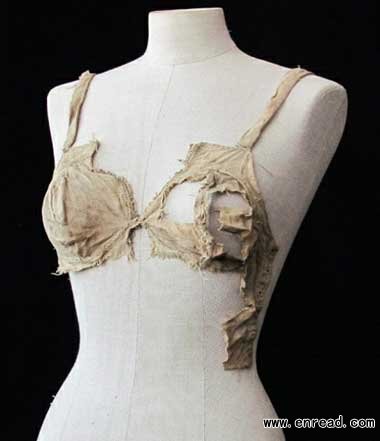| ||||||||||||||||||||||||||||||||||||||||||||||||
|
It is hardly racy by today's standards but this skimpy lingerie has certainly shocked historians.
虽然根据现代标准,这些小而暴露的内衣很难让人眼前一亮,但它足以令历史学家惊讶。
 vault1 at Lengberg Castle in East Tyrol and is thought to date back to the 15th century." style="cursor:pointer" onclick="window.open('/upimg/allimg/120721/1_120721060604_1.jpg')" /> vault1 at Lengberg Castle in East Tyrol and is thought to date back to the 15th century." style="cursor:pointer" onclick="window.open('/upimg/allimg/120721/1_120721060604_1.jpg')" />Foundations of history: This bra was discovered hidden in a vault at Lengberg Castle in East Tyrol and is thought to date back to the 15th century. The lace(花边) and linen2(亚麻布) undergarments date back to hundreds of years before women's underwear was thought to exist.
They had lain hidden in a vault beneath the floorboards of an Austrian castle since the 15th century.
Despite their state of decay, the knickers(灯笼裤,短裤) bear more than a passing resemblance to the string bikini briefs popular today, while the bra has the fitted cups and delicate straps3 of its modern-day counterparts.
While it was known that medieval men wore undergarments like modern-day shorts, it was thought that their womenfolk simply wore a smock(罩衫) or chemise(女睡衣) , and that knickers didn't make an appearance until the late 18th century.
Bras were thought to be an even more modern invention, not appearing until around 100 years ago.
However, Hilary Davidson, fashion curator at the Museum of London, said the discovery 'totally rewrites' fashion history, adding: 'Nothing like this has ever come up before.'
She believes it is 'entirely4 probable' that something similar was worn by Britain's medieval women.
She said: 'These finds are a very exciting insight into the way people dressed in the Middle Ages.
The undergarments were among almost 3,000 fragments of clothing and other detritus5 found in Lengberg Castle in East Tyrol during recent renovations.
It is thought that they were buried when the building was extended in 1480 and that the exceptionally dry conditions stopped the fragile garments from disintegrating6 over the centuries.
点击  收听单词发音 收听单词发音
|
||||||||||||||||||||||||||||||||||||||||||||||||
上一篇:指甲油、发胶会增加患糖尿病风险 下一篇:少吃咸食能降低患胃癌风险 |
||||||||||||||||||||||||||||||||||||||||||||||||
- 发表评论
-
- 最新评论 进入详细评论页>>



